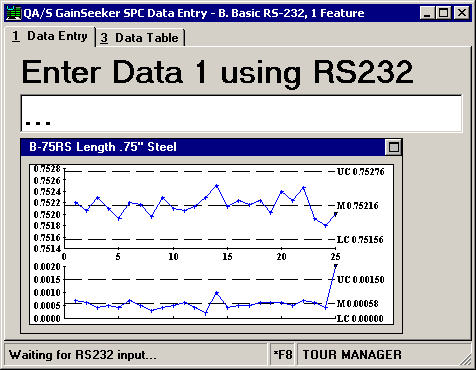
When your data entry session is ready for you to enter data from an RS-232 device, it will display a screen similar to the following:

There are three indications that the template is ready to accept data from the RS-232 device:
the data prompt (Enter Data 1 using RS232)
the three dots (...) in the data input box
the text in the lower left corner of the screen (Waiting for RS232 input...)
At this point in the data entry session, you can perform one of three actions:
Send the reading from your RS-232 device
To enter the data value, press the footswitch, send button, or other trigger on your RS-232 device.
Interrupt the RS-232 input to perform another task
To access any of the menu options, tabs or buttons on the main data entry screen, you must first interrupt the RS-232 input by pressing the F8 key or by clicking *F8 on the bottom of the screen. This removes the three dots (...) from the data input box.
To resume RS-232 input when the cursor is blinking in the data input box, press ENTER.
Use the keyboard instead of RS-232 input
To bypass the RS-232 device and type the data values via keyboard, press CTRL+K. This removes all screen references to RS232, including the three dots (...) in the data input box, and it allows you to type the data values for the current standard.
This is a convenient way to continue entering data if the RS-232 device is broken, out for calibration, or otherwise unavailable.
If you use this data entry session to enter data for multiple standards, such as multiple characteristics of one part number, then you must press CTRL+K when the data entry session reaches a new standard. You will recognize when the data entry session reaches a new standard by the data input prompt at the top of the screen (Enter Data 1 using RS232) and by the status bar text at the lower left corner of the screen (Waiting for RS232 input...).
Tip: You can press CTRL+K to bypass the RS-232 device from any input cell for the current standard, not just from a Data cell.
|
|